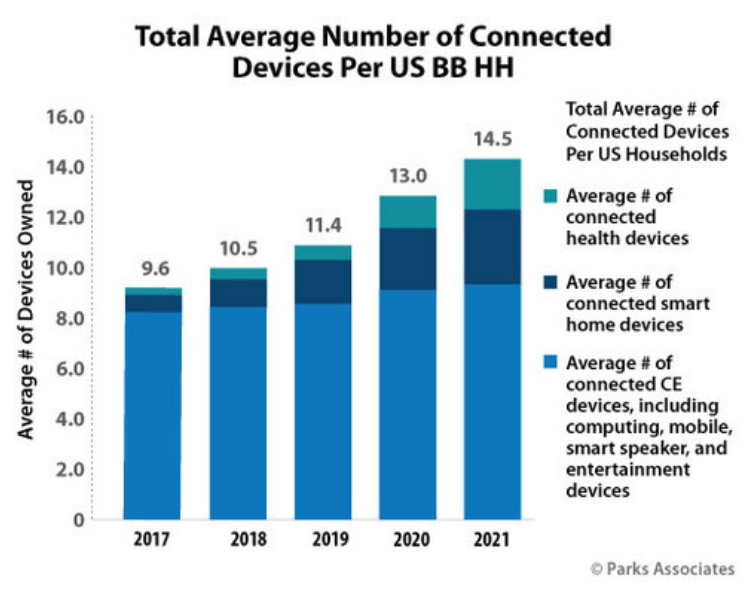Adoption of the connected lifestyle continues to expand as the supporting technologies mature and the value propositions of smart, connected devices and streaming services are better understood by consumers. Crossover opportunities are emerging between ecosystems in home security, home controls, entertainment, and energy sectors, among others.
Currently, according to Parks Associates research, the average internet household has 14.5 connected devices including connected entertainment, connected health devices, and smart home devices, and now 36% of all internet households have a least one smart home devices. Smart home devices provide an increased level of convenience for consumers through home automation and home security applications, energy management and energy efficiency services, new video distribution options through various connected devices, and the ability to control and monitor the home remotely.
Parks Associates definition of a smart home device:
A smart home device connects to the internet. Users can access the device, monitor its status, control its functions, and/or receive alerts when necessary. These actions occur through an app on the user’s smartphone, or through a tablet or computer. A smart home device is a single-point device with the intelligence embedded in the device or combined with intelligence provided by software in the cloud. It typically supports cloud-based data and analytics. Smart home devices operate independently of higher-level controllers. Some communicate with other smart home devices, and some reside as a client of a smart home central controller or smart home subsystem. The intelligence can be housed in the device or use software from a cloud platform. Smart home devices can be purchased one at a time, or as a bundle, and may or may not be part of an integrated system.
Key factors impacting the growth of the connected home include:
Interoperability is Key in the Connected Home
Interoperability will be essential to long-term success in the connected consumer market. Parks Associates research consistently shows interoperability between devices as consumers’ top consideration when purchasing connected devices. To succeed in markets that are being dominated by only a handful of consumer technology ecosystems, all players must develop an API strategy that enables partnerships and expands capabilities and distribution channels.
5G Speeds Will Impact Multiple Industries
The rollout of 5G technologies can appease increasing consumer and industrial demand for improved connectivity solutions and networks. 5G technologies will ultimately ease the burden on mobile networks and smart homes while providing much quicker broadband speeds and more reliable connectivity. These improvements will target the billions of new IoT devices that will connect to operators’ networks over the next decade and beyond. With 5G implementation, connected markets that are reliant on both high and low bandwidth connectivity will experience disruption.
The rollout of 5G services may allow operators to gain market share in the competitive mobile market, as well as gain a foothold in the home broadband market. Loss of connectivity with smart devices is a consistent pain point voiced by device owners, and cellular devices that can offer stand-alone, plug-and-play connectivity with little to no downtime will be compelling.
Voice Control and Ecosystem Development
Voice-based platforms—such as Amazon Alexa and Google Assistant—are increasingly the de facto hub in the connected home. More than half of US broadband households owned at least one smart speaker with a voice assistant according to Parks Associates Q1 2021 research. These devices allow consumers to build their own personalized ecosystem by incrementally adopting compatible point solutions that require little or no installation effort. This DIY approach provides a simplified, lower-cost path into the smart home for the mass market.
Distributed Intelligence is Emerging
Innovation in the cloud has evolved at a rapid pace. Abstraction layers and API management services are delivering the technology to enable distributed intelligence. As new technologies emerge, players will have to evolve in their approach. Many future systems will use a distributed control strategy with a voice user interface as the only centralized function. However, not all offerings will follow this strategy - service providers, security companies, and high-end system integrators have designed their offerings with a centralized control infrastructure instead. As voice vies for dominance, stakeholders in the smart home arena will need to understand how voice interfaces impact their strategies and how to adjust strategies moving forward.
Securing the Smart Home Could Be One of the Largest Recurring Revenue Opportunities
ISPs are in a very good position, as they already have a subscription-based relationship with their end customers. They are in the perfect position to secure the connection to their smart homes, thus securing their devices, regardless of their platforms, operations systems, or any other specifics. Advanced network security offerings use robust AI for device identification, network analytics, and enhanced security with real-time threat prevention to provide modern protection in a world with increasing attempts at device and network hacking.
It is a very positive outlook for players in the consumer technology markets. Parks Associates is dedicated to providing the most reliable and accurate view of the connected home market, based on its data of quarterly surveys of 10,000 internet households.


